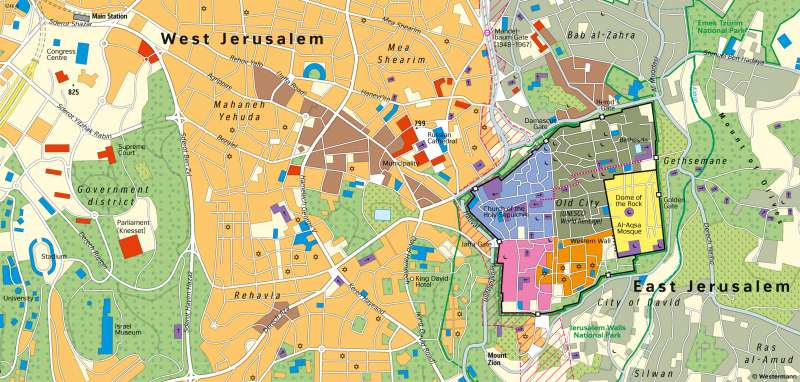Jerusalem - Holy city of three world religions
Religious faiths
978-3-14-100890-6 | Page 40 | Ill. 2

Overview
Jerusalem (Hebrew: Yerushaláyim, Arabic: al-Quds), the capital of the State of Israel, is located in the mountains of Judea, about halfway between the Mediterranean Sea and the Dead Sea. Jews make up just under two-thirds of the population (about 920,000 inhabitants in 2018) and Muslims about one-third, while Christians form a minority of about two per cent.
The Old City
The roughly one-square-kilometre Old City, now home to about 50,000 inhabitants and declared a UNESCO World Heritage Site in 1981, is enclosed by a 16th-century city wall. Built under the Ottoman ruler Sultan Süleyman, it gives this part of the city its present form, including a Jewish, a Christian, an Armenian and a Muslim quarter. Within these walls, the sacred sites of the three monotheistic world religions are located in a very confined space.
In the eastern part, situated on a plateau, the golden Dome of the Rock and the Al-Aqsa Mosque are symbols of the Old City. After Mecca and Medina, it is one of the most important Islamic holy sites, as it is a traditional setting of the nocturnal rapture of the Prophet Mohammed, linked to the later tradition of his legendary journey to heaven. According to Jewish tradition, it was the site of the First and Second Temples, which were destroyed by the Romans in 70 AD. Additionally, the "Wailing Wall", formerly the western wall of the Jewish Temple Mount, is an important place of prayer for Jews today. The "topographic" side of the Palestine conflict becomes particularly tangible here since Muslim and Jewish shrines are located very close together.
In the northwest of the Old City, the Church of the Holy Sepulchre from the 4th century is located. According to Christian tradition, it is the place of crucifixion and of the empty tomb of Jesus Christ. The Via Dolorosa, with the last stations of the Passion of Jesus, leads to the Church of the Holy Sepulchre through the Muslim quarter.
There are eight city gates from different eras in the Old City wall. The Golden Gate, which leads to the Temple Mount and was walled up under Ottoman rule, will be reopened with the coming of the Messiah, according to Jewish tradition.
Other places with religious or spiritual significance are located outside the Old City. On Mount Zion in the south, Jews place the tomb of King David, and right next to it, according to Christian tradition, Jesus celebrated his Last Supper. The Mount of Olives with the Garden of Gethsemane in the east is considered the place of Jesus' arrest. The Jewish cemetery on the Mount of Olives and the Muslim cemetery at the foot of the Dome of the Rock are also important religious sites.
Neighbourhoods of the New City
Outside the Old City, there is a Jewish New City in the western half and an Arab New City in the eastern half, both with their own residential areas and economic centres.
The history of the Jewish New City began at the end of the 19th century. With the rise of the Zionist movement, more Jews immigrated to Jerusalem and new residential areas were built outside the Old City. Me’a She’arim, built from the 1870s onwards, was and still is the centre of Jewish Orthodoxy with its prayer rooms, synagogues, and Talmud schools, where life, especially on the Sabbath, is still governed by the rules of the Torah and Talmud. Today, the main business centre and the Jerusalem municipality are located in its south. The Rehavia district was built from the 1920s onwards and was settled preferentially by European immigrants.
In East Jerusalem, the Bab al Zahra neighbourhood developed into a new business centre, especially after the division of the city in 1948. The City of David neighbourhood and the former Arab village of Silwan are among the traditional Palestinian residential areas.
The "no man's land" was a result of the 1948 War of Independence, in which Israel lost eastern Jerusalem with the Old City to Jordan. A narrow corridor west of the Old City blocked the Jews' access to the Wailing Wall and the old Jewish quarter until 1967. It was not until the "Six-Day War" that Israel recaptured the Old City.




